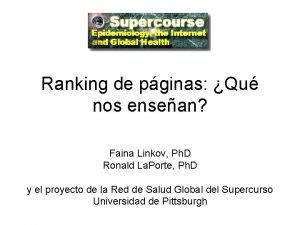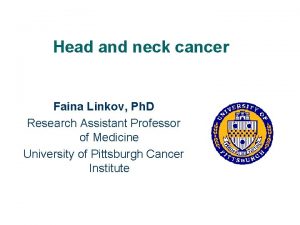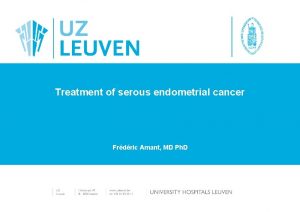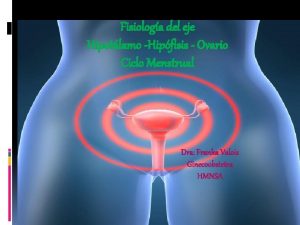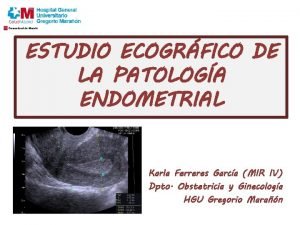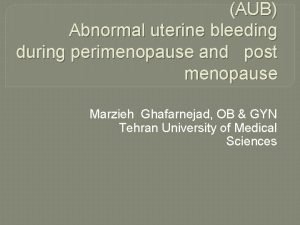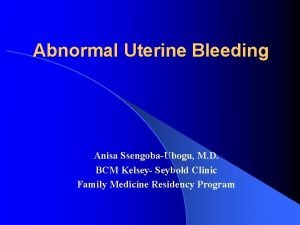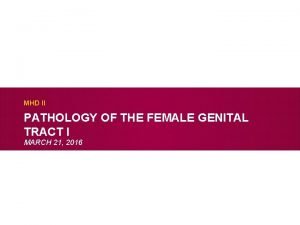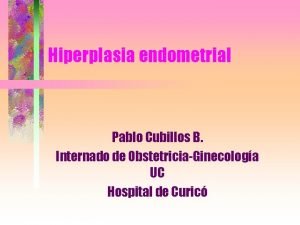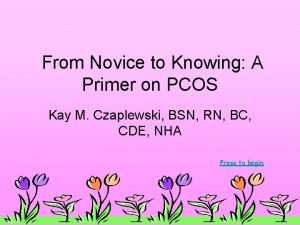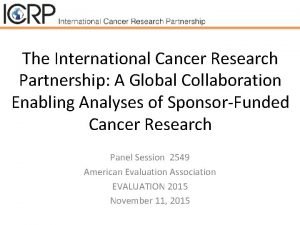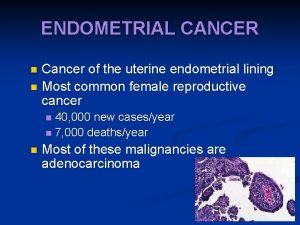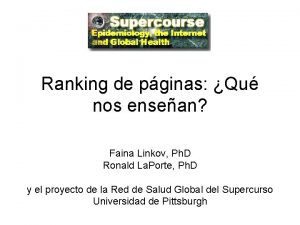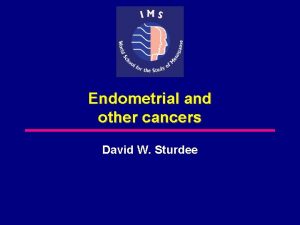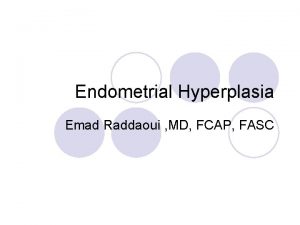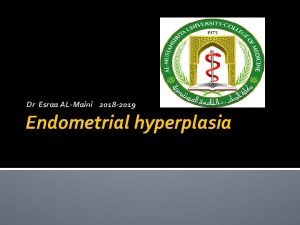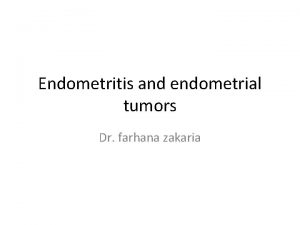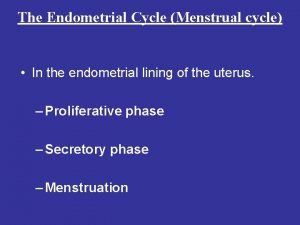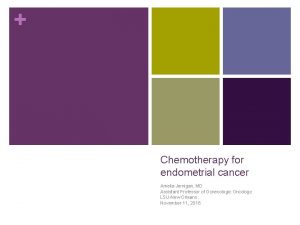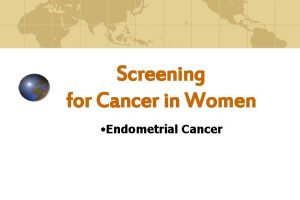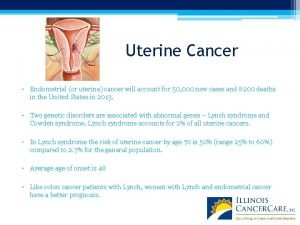Endometrial Cancer Faina Linkov Ph D Research Assistant






















- Slides: 22

Endometrial Cancer Faina Linkov, Ph. D Research Assistant Professor University of Pittsburgh Cancer Institute

GENERAL OVERVIEW OF GYNECOLOGIC CANCERS • 79, 480 new cases/yr of female genital system cancers in the U. S. • 28, 910 deaths in U. S. from genital system cancers in 2005 • Diet, exercise and lifestyle choices play important roles in the prevention of cancer • Knowledge of family history also increases prevention and early diagnosis rates • Regular screening and self-examinations for appropriate cancers early detection early intervention & therapy

Endometrial Cancer • Strong association with excess weight

Adipose tissue: Consequences of Obesity on Cancer Development Obesity has been implicated in the development of • Type 2 diabetes • Heart disease • Stroke • Hypertension • Gallbladder disease • Osteoarthritis • Sleep apnea • Asthma • Psychological disorders or difficulties • Some cancers, including ovarian, cervical, breast, and endometrial • • • Dyslipidemia Complications of pregnancy Hirsuitism Menstrual abnormalities Stress incontinence Increased surgical risk

Endometrial Cancer and Lifestyle

Important Definitions • Obesity: having a very high amount of body fat in relation to lean body mass, or Body Mass Index (BMI) of 30 or higher for adults. • Body Mass Index (BMI): a measure of weight in relation to height, specifically weight in kilograms divided by the square of his or height in meters. • Morbid Obesity-100 pounds above ideal weight or BMI over 40 (indication for bariatric surgery) • Bariatric surgery is the term for operations to help promote weight loss.

Obesity Trends* Among U. S. Adults BRFSS, 2005 (*BMI ≥ 30, or ~ 30 lbs overweight for 5’ 4” person) No Data ≥ 30% <10% 10%– 14% 15%– 19% 20%– 24% 25%– 29%

ENDOMETRIAL CANCER • Cancer of the uterine endometrial lining • Most common female reproductive cancer – 40, 000 new cases/year – 7, 000 deaths/year • Most of these malignancies are adenocarcinoma

Incidence and Prevalence • • • Most common gynecologic cancer 4 th most common in women (US) 2 nd most common in women (UK) 5 th most common in women (worldwide) Western developed > Southeast Asia Increase in the 1970’s – Increased use of menopausal estrogen therapy

RISK FACTORS FOR ENDOMETRIAL CANCER • Early menarche (<age 12) • Late menopause (>age 52) • Infertility or nulliparous • Obesity • Treatment with tamoxifen for breast cancer • Estrogen replacement therapy (ERT) after menopause • Diet high in animal fat • • Diabetes Age greater than 40 Caucasian women Family history of endometrial cancer or hereditary nonpolyposis colon cancer (HNPCC) • Personal history of breast or ovarian cancer • Prior radiation therapy for pelvic cancer

Endometrial Carcinoma Etiology • Unnoposed estrogen hypothesis: exposure to unopposed estrogens Pathology • Spreads through uterus, fallopian tubes, ovaries and out into peritoneal cavity – Metastasizes via blood and lymphatic system

SYMPTOMS OF ENDOMETRIAL CANCER • Symptoms – Non-menstrual bleeding or discharge • Especially post-menopausal bleeding – Heavy bleeding – Dysuria – Pain during intercourse – Pain and/or mass in pelvic area – Weight loss – Back pain

ENDOMETRIAL CANCER • Diagnosis – Pelvic examination – Pap smear (detect cancer spread to cervix) – Endometrial biopsy – Dilation and curettage – Transvaginal ultrasound • Treatment – Surgery • Hysterectomy • Salpingo-oophorectomy • Pelvic lymph node dissection • Laparoscopic lymph node sampling – Radiation therapy – Chemotherapy – Hormone therapy • Progesterone • Tamoxifen

Endometrial hyperplasia • Overgrowth of the glandular epithelium of the endometrial lining • Usually occurs when a patient is exposed to unopposed estrogen, either estrogenically or because of anovulation • Rates of neoplasm – simple hyperplasia: 1%. – complex hyperplasia with atypia: 30%

Endometrial Hyperplasia • Complex hyperplasia with atypia – One study found incidence of concomitant endometrial cancer in 40% of cases – Hysterectomy or high dose progestin tx • Simple – Often regress spontaneously – Progestin treatment used for treating bleeding may help in treating hyperplasia as well

• Estrogen dependent disease – Prolonged exposure without the balancing effects of progesterone • Premalignant potential – Endometrial hyperplasia – Simple => 1% – Complex => 3% – Simple with atypia => 8% – Complex with atypia => 29%

Reduced Risk • Oral Contraceptives – Combined OC => 50% reduced rate – Actual reduction number small because uncommon in women of child bearing age – Long term offers protection – Reduced risk presumably => progesterone • Tobacco Smoking – Some evidence that it reduces the rate – Smokers have lower levels of estrogen and lower rate of obesity

Prevention and Survival • Early detection is best prevention • Treating precancerous hyperplasia – – Hormones (progestin) D&C Hysterectomy 10 ~ 30% untreated develop into cancer • Average 5 year survival – – Stage I => 72 ~ 90% Stage II=> 56 ~ 60% Stage III => 32 ~ 40% Stage IV => 5 ~ 11%

Potentially modifiable risk factors Dietary factors Isoflavones: Phytoestrogens that have properties similar to selective estrogen receptor modulators Soy, beans, chick peas…

Dietary fiber Increases estrogen excretion and decreases estrogen reuptake: whole grains, vegetables, fruits, and seaweeds

Exercise?

Summary points • Endometrial cancer is one of the leading gynecological cancers in the US • Obesity is one of the key factors involved in Endometrial cancer development • More research is needed to explore modifiable risk factors in endometrial cancer development
 Faina linkov
Faina linkov Faina linkov
Faina linkov Endometrial cancer
Endometrial cancer Endometrial cancer
Endometrial cancer Loris faina
Loris faina Fase proliferativa y secretora
Fase proliferativa y secretora Grosor normal del endometrio
Grosor normal del endometrio Postmenopausal endo thickness
Postmenopausal endo thickness Endometrial cells
Endometrial cells It projektov�� mana����r
It projektov�� mana����r Progesterone breakthrough bleeding
Progesterone breakthrough bleeding Uterus diagram
Uterus diagram Uterine ablation
Uterine ablation Describe the picture
Describe the picture Pablo cubillos
Pablo cubillos Endometrial histology menstrual cycle
Endometrial histology menstrual cycle Teratoma ovarium
Teratoma ovarium Assistant manager career path
Assistant manager career path International cancer research partnership
International cancer research partnership Shaukat khanum memorial cancer hospital and research centre
Shaukat khanum memorial cancer hospital and research centre Wagholi cancer research center
Wagholi cancer research center Northern institute for cancer research
Northern institute for cancer research What are writing conventions
What are writing conventions
